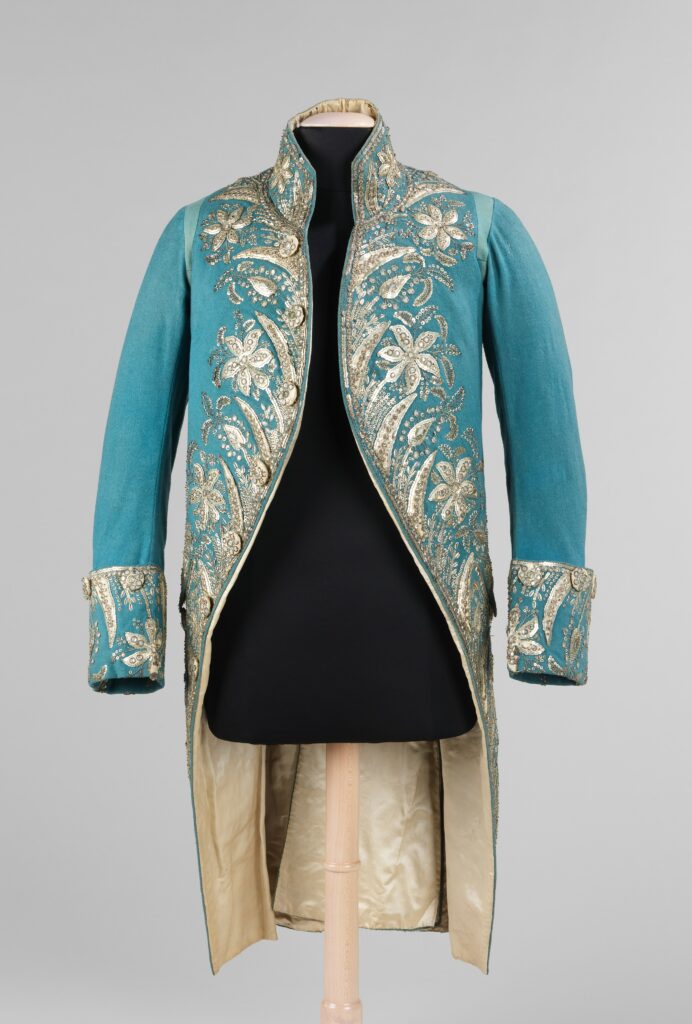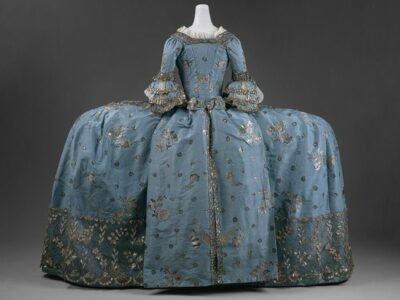By Summer Anne Lee

When you think of fashion in 18th-century London, you might picture powdered wigs, fancy dresses, and buckle shoes. But did you know that fashion could lead 18th-century Londoners down the path of crime? From the theft of clothing and textiles to the smuggling of contraband lace, learn more about fashion and crime in 18th-century Covent Garden!
FASHION IN 18TH-CENTURY LONDON
The basic components of a well-dressed Englishman’s ensemble remained the same throughout the 18th century. The first garment a man put on was a pristine white undershirt with a high collar, worn underneath a waistcoat and coat. On his legs, he wore tight, knee-length trousers called breeches worn over stockings and drawers. On his feet, he wore leather shoes fastened with ties or extravagant buckles. To complete the look, stylish 18th-century men wore fashionable accessories including stiff cravats around their necks, powdered wigs and tricorn hats on their heads, as well as gloves, walking sticks, and even swords.

By the mid-18th century, English men’s fashion gained a reputation for being more somber than that of the French. However, there was one group of London men, from circa 1760-1780, who are famously remembered for their flamboyant clothing: the Macaronis.[1] This term refers to fashion-obsessed men, of the aristocracy and working class alike, who were inspired to emulate continental style. Their clothing was more colorful and ornate than the standard Englishman’s, and they wore cosmetics and over-the-top accessories. The satirical print The Covent Garden Macaroni (Fig. 2), in the collection of the British Museum, is one of many contemporary depictions of these fascinating men.
As the 18th century progressed, women’s fashion changed quite a bit. Yet at every stage, a fashionable woman’s ensemble began with her loose, white chemise. This was followed by more structural undergarments that helped create the ideal silhouette of the time. A predecessor of the corset known as “stays” molded the torso into a more conical shape. Wide skirts were supported through a variety of underpinnings: from basket-like hoops and padded rolls worn at the hips to false rumps. Fine stockings, garters, and high-heeled shoes were mostly unseen underneath long skirts.

Different types of gowns were in fashion at different parts of the century, and each was constructed differently. At the beginning of the century, the prevailing fashion was a T-shaped one-piece gown called a mantua. By 1715, the mantua evolved into a new style known as the Robe à l’Anglaise, meaning “English gown” in French (Fig. 3).[2] In France, other dress styles were emerging. The loose-fitting robe volante was fashionable during the 1720s and 1730s and evolved into the Robe à la Française, or “French gown” (Fig. 4). Both of these styles featured long pleats at the back, which became known as a “Sacque” in England. All of these dress styles were floor-length with wide skirts displaying the fine quality of their dress fabric.

In 1787, a man named John Haleniz advertised in the Times that he sold “stays, habits, sacques, robes, slips, mantuas, and all sorts of fancy dresses, in the genteelest taste, and on the most reasonable terms” out of his business at No. 1, York Street, Covent Garden.[3] And indeed, by the 1780s, even more styles emerged in London: such as the Robe à la Polonaise, with its looped-up overskirt, the redingote, inspired by English men’s riding coats, and the cotton robe en chemise.
Fashionable accessories for the 18th-century woman included folding fans, fancy parasols to protect from the sun, and various forms of headwear adorned with feathers, flowers, and ribbons.
18TH-CENTURY FASHION POLICE
When you look at 18th-century clothing painted in English portraiture, or the surviving garments preserved in museums, many of them appear expensive and luxurious. While intricately embroidered waistcoats and breathtaking gowns of brocaded silk were certainly reserved for the upper-class, working-class people did not dress completely differently than the aristocracy. It’s true that Londoners like those who sold their goods at the Covent Garden market would have needed more useful accessories, like an apron rather than a powdered wig or elaborately painted fan (Fig. 5). However, the cut and construction of their garments would have been quite similar — with the primary difference being the quality and expense of the fabric and trimmings.

The poor and working-class likely had their clothing made from relatively affordable, lower-quality textiles, or even inherited or purchased clothing second-hand. There was a strong second-hand clothing market in 18th-century London, and clothing and textiles made up a great portion of goods sold by English pawnbrokers.[4] Clothing was so valuable that it could be the target of theft — as was the case in one incident described in this 1785 report of Old Bailey Intelligence in the Times:
“Elizabeth Morris was accused of having stolen some clothes and other articles in a house near Drury Lane … she accordingly said, that she had bought the clothes in Monmouth Street. The witnesses flatly denied this to be true, saying that the clothes had never been out of the house, and therefore it was impossible that she could have bought them in Monmouth Street. The prisoner being asked how the clothes had found their way into the house where she was stopped … replied, ‘O, my lord, I don’t know that, but I know I bought them in Monmouth Street.’ At this the whole court burst out laughing, in which they indulged the more, as the conviction of the prisoner would not be attended with death. The jury found her guilty.”[5]
Sumptuous silk and imported cotton textiles were also incredibly costly, making them an obvious target for theft. In 1790, the Times reported out of Bow Street that a Covent Garden silk mercer named Mr. Robert King charged William Fittler with “knowingly and by false pretenses obtaining from him eight yards and a quarter of black Florentine silk, of the value of 3l. 18s. with intent to defraud him and Richard Gouldsmith.”[6] Fittler allegedly fooled King into the exchange with a forged letter “as an order for the silk from Lord Arundel.” Another 1785 report of Old Bailey Intelligence in the Times described a child named Jane Thacker who was tried (and acquitted) for stealing fourteen yards of black lace at a public house near Clerkenwell.[7]
The textile industry was so lucrative that many countries, including England, heavily regulated the purchase of foreign textiles and lace — meaning that even the most wealthy and privileged could become fashion outlaws.


The clothing of the Georgian court was not the same as that of the London streets. Court dress was extremely formal, and its regulations around dress required expense to the wearer. Rather than following the English fashion for austere menswear, English court suits were lavishly adorned with hand-worked embroidery, which is demonstrated in the circa 1775–89 court coat in The Metropolitan Museum of Art’s collection (Fig. 6). Women wore elaborate court mantuas with fitted backs and extremely wide skirts, like the circa 1750 example also from The Met (Fig. 7). These court styles were not only decorated with fine needlework, as in the examples from The Met, but also trimmed in sumptuous lace. Even after the French Revolution, when the frilly fashions associated with the ancient regime fell out of fashion in both France and England, lace remained a mainstay of English court fashions.[8]

Although lace was made in England, the most fashionable Londoners of the 18th century desired luxurious lace made in Belgium and France (Fig. 8). This meant a great amount of money was going into foreign economies. In order to protect the English lace-making industry, foreign lace from certain countries was prohibited from entering England. This also applied to court fashions. In fact, in 1764, King George III ordered that no one in attendance at the wedding of his sister, Princess Augusta, could wear any foreign lace (Fig. 9).[9]
This lace prohibition inspired many creative forms of smuggling. Attempts to conceal and smuggle foreign lace into the country were made using turbans, loaves of bread, the lining of a carriage, and even coffins.[10] However, the customs officers were eager to seize contraband, and even had spies on the watch. According to The Quarterly Review:
“Ladies of rank were stopped in their chairs in Fleet Street of Covent Garden, and relieved by the officers of the customs of French lace to which they could not show a satisfactory title. Even ladies, when walking, had their mittens cut off their hands, if supposed of French manufacture.”[11]

Bibliography
- Gifford, W, Coleridge, J. T., Lockhart, J. G., Elwin, W., Macpherson, W., Smith, W., Murray, J., Prothero, R. E., & Prothero, G. W. (1868). The Quarterly Review, Volume 125. John Murray. Accessed June 29, 2023. https://books.google.com/books?id=XnpHAAAAYAAJ
- José, F., B., Doering, M. D., Hunt-Hurst, P., & Lee, H. V. (2015). Clothing and Fashion: American Fashion from Head to Toe (Vols. 1–4). ABC-CLIO.
- Lemire, Beverly. “Shifting Currency: The Culture and Economy of the Second Hand Trade in England, c. 1600–1850.” In Old Clothes, New Looks: Second Hand Fashion, edited by Alexandra Palmer and Hazel Clark, 29–48. Dress, Body, Culture. (2005). Oxford: Berg Publishers. Accessed June 29, 2023. http://dx.doi.org/10.5040/9781847888815/OCNL0009.
- McNeil, Peter. “Macaroni Dress.” In The Berg Companion to Fashion, edited by Valerie Steele. (2010). Oxford: Bloomsbury Academic. Accessed June 28, 2023. http://dx.doi.org/10.5040/9781474264716.0010754.
- “Old Bailey Intelligence.” Times, 14 Jan. 1785, p. 3. The Times Digital Archive, link-gale-com.i.ezproxy.nypl.org/apps/doc/CS50593838/TTDA?u=nypl&sid=bookmark-TTDA&xid=4e599507. Accessed 28 June 2023.
- “Public Office, Bow-Street.” Times, 10 Aug. 1790, p. 3. The Times Digital Archive, link-gale-com.i.ezproxy.nypl.org/apps/doc/CS50727690/TTDA?u=nypl&sid=bookmark-TTDA&xid=77474608. Accessed 28 June 2023.
- “To The Ladies.” Times, 21 Feb. 1787, p. 1. The Times Digital Archive, link-gale-com.i.ezproxy.nypl.org/apps/doc/CS16909397/TTDA?u=nypl&sid=bookmark-TTDA&xid=edefece2. Accessed 28 June 2023.
[1] McNeil 2010.
[2] José et. al 2015
[3] “To The Ladies” 1787
[4] Lemire 2005
[5] “Old Bailey Intelligence” 1785
[6] “Public Office, Bow-Street” 1790
[7] Ibid
[8] Gifford et. al 1868
[9] Ibid
[10] Ibid
[11] Ibid

